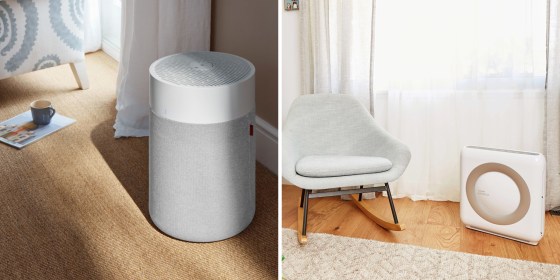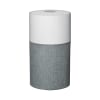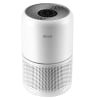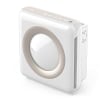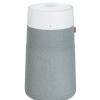Air purifiers can be an effective way to clean your indoor air, according to the Environmental Protection Agency. And while I love the idea of drifting off to sleep next to one, some air purifiers can be as noisy as an air conditioner, in my experience.
To find the best quiet air purifiers, we spoke with filtration and noise experts, and tried out different top-rated models to find ones that work quietly and effectively.
SKIP AHEAD NBC Select staff-favorite quiet air purifiers in 2025 | How to shop for a quiet air purifier
How we picked the best quiet air purifiers
We spoke with filtration and noise experts to learn more about how air purifiers work. Combining their advice with our personal experience using air purifiers, we selected products with the following criteria in mind:
- Sound level: According to the CDC, prolonged exposure to sound levels above 70 dbA can annoy you and damage your hearing over time. We only selected air purifiers with a maximum noise level under 60 decibels, the sound of a normal conversation. According to our experts, air purifier decibel levels are self-reported by the manufacturers, so we tried every one of our top picks to confirm noise levels in-person.
- Filtration: Per expert guidance, we looked for purifiers with a clean air delivery rating (CADR, learn more in our FAQ section) equal to about two-thirds of their room size recommendations.
- Independent testing: We noted if the product had been independently tested by the Association of Home Appliance Manufacturers (AHAM), which certifies the performance of air purifiers through its AHAM Verifide program.
- Smart features: We preferred air purifiers with smart features like Wi-Fi connectivity and auto air quality detection — if those features didn’t drastically increase pricing.
Our favorite quiet air purifiers of 2025
All of our top picks come from large brands like Blueair and Coway. We used each in our homes for at least two months, making sure they did not emit more than 60 decibels of sound, even on their highest setting.
Best budget: Blueair Pure 511
- Small
- Fabric pre-filter
- Affordable
- Nothing at this time
NBC Select commerce editor Lindsay Schneider received one of these air purifiers from the brand when it launched in 2023 and promptly bought a second one after seeing all the dust it collected. It pulls unfiltered air from all directions around the base and pushes clean air out through the top. It also has a removable, machine-washable mesh fabric cover over the base that catches larger clumps of dust, lint and hair.
Noise-wise, it is “definitely noticeable” on its highest setting, but it sounds more like white noise than anything else — you get used to it quickly, says Schneider. The low and medium settings are much quieter.
It’s one of the smallest and lightest purifiers on our list at under five pounds, making it easy to fit in any sized space.
Room Size: 180 sq. ft. | Decibels: 24 - 49 dB | CADR (CFM): smoke: 112, dust: 112, pollen: 112 | Filter lifespan: ~6 months | Connectivity: n/a | Speeds: 3 | Weight: 4.2 lbs | AHAM verified: Yes | Quiet Mark certified: No
Best for small spaces: Levoit Core 300
- Small size
- Good value for filtration
- No smart connectivity
NBC Select updates editor Mili Godio keeps this affordable air purifier in her bedroom — she can barely hear it throughout the day and night. Like most of our top picks, it has three filtration speeds and a sleep mode that runs at the quietest speed possible. If you are sensitive to lights, especially while sleeping, you can turn the top screen and lights off while keeping the purifier on.
It has a compact circular design that makes it easy to place in most small spaces, in our experience. This model does not have smart connectivity — if that is a deal breaker for you, consider the slightly pricier Levoit Core 300s instead.
Room Size: 219 sq. ft. | Decibels: 24 - 50 dB(A) | CADR (CFM): smoke: 141, dust: 140, pollen: 145 | Filter lifespan: ~6 to 8 months | Connectivity: n/a | Speeds: 3 | Weight: 7.5 lbs | AHAM verified: No | Quiet Mark certified: No
Best for medium spaces: Coway Airmega AP-1512HH Mighty
- Auto filtration mode
- Easy to use controls
- No smart connectivity
NBC Select associate updates editor Zoe Malin uses this air purifier in her main living space. Most of the time, she forgets it’s there — it is not very noisy or noticeable.
Malin, who has two cats, is sensitive to dust and allergens, and has used air purifiers for years. She put this one in auto mode, where it automatically changes speeds depending on the air quality detected. It usually stays at the lowest setting, says Malin, but if she is cooking a large meal, it will change to a higher setting, acting as a good reminder to turn on a vent or maybe open a window, says Malin.
While it is compact, this air purifier is heavier than our other recommendations at 12.3 pounds.
Room Size: 330 sq. ft. | Decibels: 24 - 53 dB | CADR (CFM): smoke: 234, dust: 248, pollen: 232 | Filter lifespan: ~12 months | Connectivity: n/a | Speeds: 3 | Weight: 12.3 lbs | AHAM verified: No | Quiet Mark certified: No
Best for large spaces: Blueair Blue 311i+ Max
- Great filtration
- Fabric pre-filter
- Smart connectivity
- Nothing at this time
I have used this air purifier in my main living space for years, including during 2023’s Canadian wildfire season. It is very quiet, never more noticeable than daily ambient indoor and outdoor noise.
Similar to our budget pick, it pulls in unfiltered air from all directions into the base, and pushes clean air out of the top. It also has a pre-filter: a large, machine-washable fabric mesh cover that catches larger clumps of lint and hair.
You can control the purifier through your phone via the Blueair app, which also shows stats like indoor air quality and filter lifespan. I use the app to put my purifier on a schedule — it changes to night mode, the lowest and quietest setting, every evening around 9PM.
Room Size: 465 sq. ft. | Decibels: 23 - 50 dB(A) | CADR (CFM): smoke: 300, dust: 300, pollen: 300 | Filter lifespan: ~6 to 9 months | Connectivity: Yes, Blueair app | Speeds: 4 | Weight: 7.9 lbs | AHAM verified: Yes | Quiet Mark certified: Yes
How to shop for a quiet air purifier
A quiet air purifier shouldn’t just be quiet, it should also clean the air in your space effectively, says Poppy Szkiler, CEO and founder of Quiet Mark, a UK-based independent global certification program that works to identify the quietest products and solutions. The trick is finding a small, effective air purifier well-suited to the square footage of your space. “You don’t want one more suited for a conference hall than your kitchen,” says Szkiler.
Decibel levels on air purifiers are largely self-reported by the manufacturer — there is no official outside body verifying decibel claims. Cross-referencing decibel numbers with consumer and professional reviews can help, in addition to reviews from outside groups like QuietMark.
You should look for HEPA-level filtration and a CADR that’s roughly two-thirds the area of your room, according to AHAM. “It sounds very scientific, but what that works out to is about four air changes per hour,” says William Bahnfleth, professor of architectural engineering at Penn State University and a Presidential Fellow of ASHRAE (American Society of Heating, Refrigerating and Air-Conditioning Engineers).
Meet our experts
At NBC Select, we work with experts who have specialized knowledge and authority based on relevant training and/or experience. We also take steps to ensure all expert advice and recommendations are made independently and without undisclosed financial conflicts of interest.
- Poppy Szkiler is the CEO and founder QuietMark, a UK-based independent global certification program that tests and verifies the quietest products and solutions to unwanted noise.
- William Bahnfleth is a professor of architectural engineering at Penn State University and a Presidential Fellow of ASHRAE (American Society of Heating, Refrigerating and Air-Conditioning Engineers).
Why trust NBC Select?
Harry Rabinowitz is a reporter at NBC Select who covers technology and has used air purifiers in his home for over four years. For this piece, he spoke with noise and filtration experts to learn more about air purifier certifications and sound levels. He and the NBC Select team tried different top-rated air purifiers in their homes, paying special attention to sound levels.
Catch up on NBC Select’s in-depth coverage of tech and tools, wellness and more, and follow us on Facebook, Instagram, Twitter and TikTok to stay up to date.
